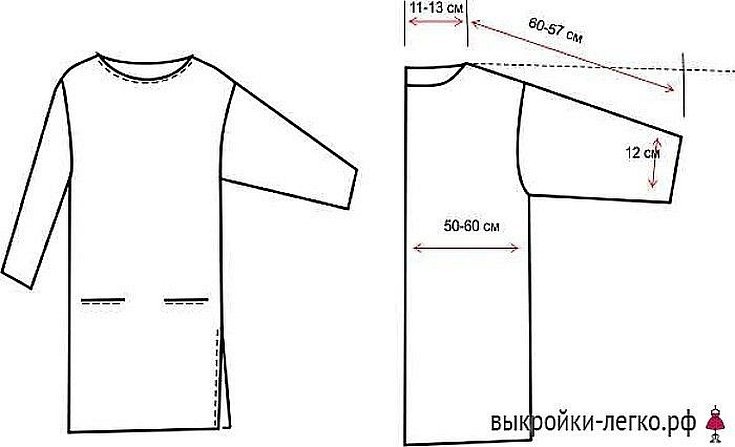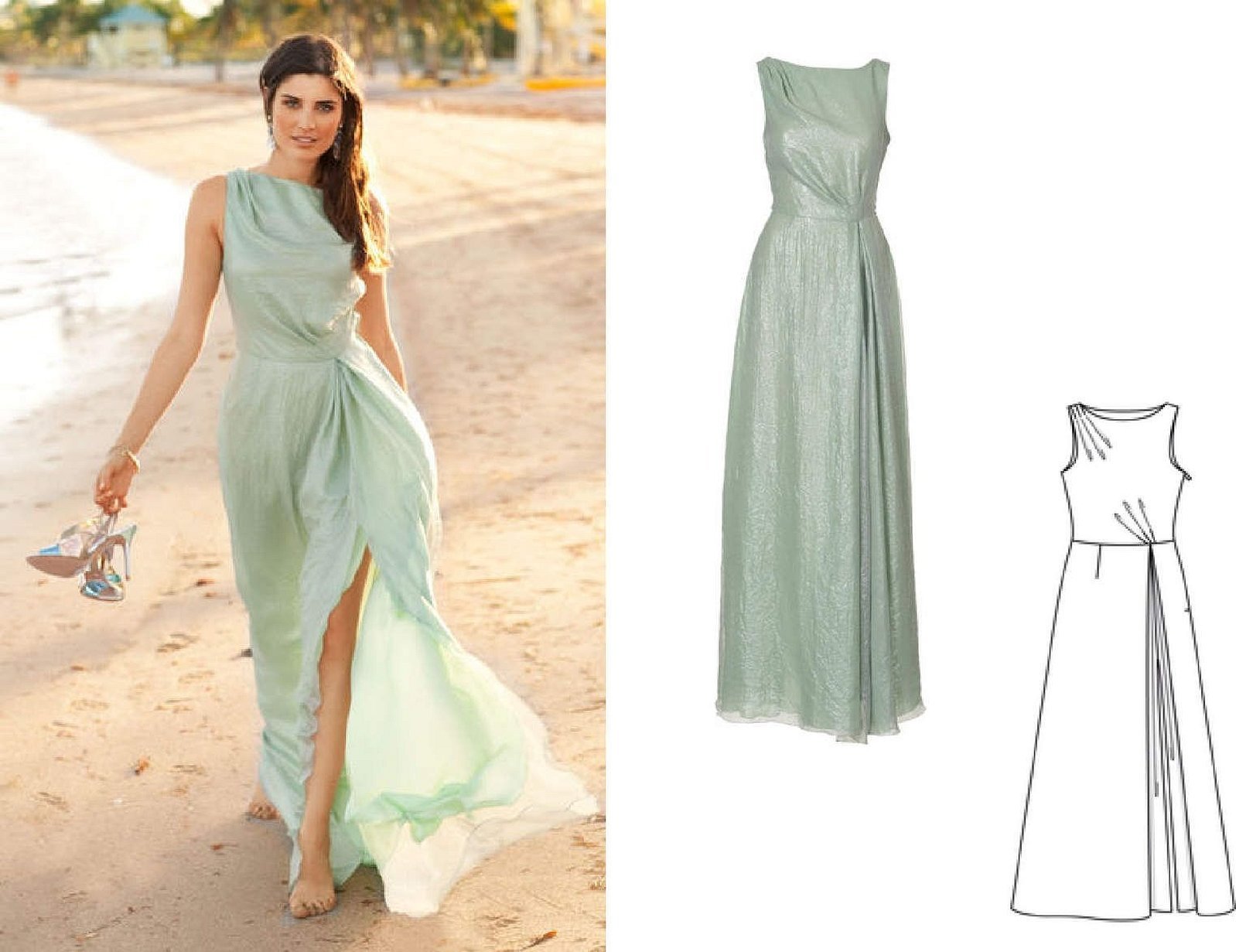Long skirts are back in fashion, and many ladies want to sew a floor-length dress. It is possible to do it yourself - you just need to choose the right material and be patient.
- Choosing a style according to your body type
- Types of Long Dresses
- Necessary materials for DIY sewing
- What you need to sew a floor-length dress
- Construction of the pattern
- Simple dress pattern for beginners
- Dress pattern with draped waist
- Summer romantic dress
- Long dresses with sun skirts
- Dress with peplum pattern
- Beach dress - pattern
- Pattern of a dress without a fastener
- Sequence of cutting and sewing
- How to sew elastic to a skirt waistband
- Belt and bow decoration
- Long dress without pattern and machine
- Pros and cons of a dress sewn by yourself
Choosing a style according to your body type
Choosing a style of a long summer (or winter) floor-length dress from a pattern is somewhat more difficult than choosing in a store with ready-made clothes. But there are no fundamental differences, especially if a picture is attached to the pattern. The main requirement for any option is that the product should fit the figure.

Types of Long Dresses
There are many types of the most common women's clothing, and they are all different from each other. For those who are just going to sew a long dress, the most convenient classification is by silhouette:
- Straight – the width of the shoulders, waist and hips differs slightly, a slight flare of the skirt, allowing you to walk freely. The usual fastener is a zipper on the back. The sleeves can be of any length. Suitable for everyday, elegant and evening wear. Slimming, visually enlarges the chest and hips, if they are small. In curvy women, it can “steal” the waist and visually reduce height. It is considered a classic option.
- Fitted – differs from straight in that it has a more pronounced waist, but the skirt remains relatively narrow.
- A-silhouette – the dress fits the upper body and waist, the skirt is very wide. Sleeves can be of any length, but the shoulders are almost always covered. Does not imply slits. The waist can be high or low. It is good for summer vacations. It emphasizes the chest and thin waist, hides the flaws of the hips and legs. It is not suitable for girls with small breasts and an athletic figure.
Important! A-line products with a high waist are called Greek or Empire style. They perfectly hide figure defects: a protruding belly, too large hips. Allow you to emphasize the chest, including a small, graceful shoulder line.
A-line – similar to A-line, only the flare starts from the shoulders. Due to the emphasis on vertical lines, it visually increases height. It does not draw attention to the figure, so it suits almost everyone. Long A-line dresses are rare.
- Form-fitting silhouette – fits the figure perfectly, emphasizes the shapes. Requires an individual approach, difficult to manufacture.
- Godet - tight-fitting to the knees and significantly wider at the bottom. Characterized by the absence of sleeves, a deep neckline, and an open back. The style is also difficult to manufacture.
Straight fitted dresses and trapezoids are considered universal options - they look good on girls of any height and with any figure. For owners of a "pear" - wide hips with a small chest, trapezoid and A-silhouette will suit. Athletic girls who want to look feminine should prefer a straight silhouette.

Necessary materials for DIY sewing
The fabric should be selected based on the style, the expected season and the setting for which the clothing is intended. To sew a simple maxi dress without experience, it is worth starting with easy-to-process fabrics - chintz, cotton or crepe satin. The fabric should be washed before transferring the pattern to it - it is not always possible to determine in advance how much it will shrink. The length of the fabric is calculated according to the pattern, the allowance for shrinkage is 10-20% of the length.
What you need to sew a floor-length dress
In addition to the fabric for sewing, you will also need other materials and tools:
- a centimeter to take measurements (to make them more accurate, it is better when the measurements are taken by another person);
- graph paper, pencil, ruler, eraser and scissors to draw the pattern and cut it out;
- tailor's chalk to transfer the pattern onto the fabric;
- for hand sewing – pins, needles, thread and scissors;
- for machine - machine, thread, scissors;
- fasteners and elastic bands for fixation at the waist;
- decorative elements.
For your information! During the process, you will have to try on the product several times in order to notice and correct errors in time.
Construction of the pattern
You can use ready-made patterns from the Internet, fashion magazines or collections of experienced seamstresses as a sample. Most often, they indicate the size of the finished product, but in order for the dress to fit better, you should create your own pattern with your measurements. It should be taken into account that the pattern indicates half of the detail, i.e. the fabric must be folded in half to get the desired result.
Simple dress pattern for beginners
The simplest cut that does not require complex manipulations.
http://mtdata.ru/u7/photo0D93/20874149031-0/original.png#20874149031
You will need the following measurements:
- half chest circumference - measured at the protruding points of the chest and shoulder blades, the resulting figure is divided in half;
- half waist circumference – measured at the narrowest point of the back;
- half hip circumference – measured around the protruding parts of the buttocks and abdomen;
- length of the product – along the back from the protruding cervical vertebra to the desired length;
- skirt width – as desired, taking into account that the skirt should not interfere with walking;
- sleeve length – from the neck to the desired length;
- shoulder circumference – at the widest point of the shoulder;
- sleeve width – according to the desired width.
The style favorably emphasizes the fabric pattern and features of the figure. And for lovers of reconstruction, it will be an excellent underdress.

Dress pattern with draped waist
The same measurements are required as for the previous model. The main difference is that the silhouette is necessarily fitted. On the front part of the pattern, diagonal lines are drawn - along them you need to cut the paper. When laying out on the fabric, gaps are made between the fragments of the pattern - this is a "reserve" for drapery.
For your information! Knitted fabrics drape well. This style allows you to hide a protruding belly.
Summer romantic dress
A simple and romantic look is a dress with a frill on the chest. You will need only three measurements - chest, hips and dress length. The pattern itself is a rectangle, where one side is the length of the dress, and the other is the circumference of the hips or chest (whichever is larger). The frill is also a rectangle, but instead of the length of the product, the desired length of the frill is used. Step-by-step instructions on how to sew such a dress:
- Construct a pattern from two rectangles.
- Transfer to fabric.
- Sew a cylinder - the main dress, sew a frill to it.
- Use an elastic band to adjust the top of the dress to the size of the chest.
A belt, clasp or other elements are not required.
Long dresses with sun skirts
The skirt can be cut together with the top or separately from it and sewn on the waistline. A master class on making such dresses can always be found online.
Dress with peplum pattern
A peplum is a second skirt at the waist. It will help to enlarge not too curvy hips, visually reduce the waist and simply create a stylish image. The peplum is no different from a skirt in its cut.
http://portniha.com/wp-content/uploads/2019/03/2.jpg
Beach dress - pattern
A wrap dress is perfect for the beach and summer holidays:
http://odezhda.guru/wp-content/uploads/2018/08/Plyazhnoe-plate-svoimi-rukami-768×859.jpg
Pattern of a dress without a fastener
A simple fitted dress that doesn't need a fastener.
http://pastenow.ru/ee6767d6946c9886b070ed34504d5ac4
Sequence of cutting and sewing
The first thing you need to do is decide on the style of the future dress. Then you should find a suitable pattern sample, take measurements and build your own individual blank. You can use it to calculate how much fabric you will need. Then you need to buy the fabric, wash it and iron it. The pattern needs to be transferred to the fabric, and the parts of the product should be sewn together. The front and back of the product should be connected first, then the sleeve parts, and then the sleeves themselves should be sewn to the dress. On the finished product, you need to carefully iron the seams.

How to sew elastic to a skirt waistband
If the dress is cut-off, this should be done at the stage of attaching the skirt to the bodice. The elastic is sewn from the inside along the upper edge of the skirt. If it is not cut-off, the elastic is sewn first to the front, then to the back, and only after that the parts are connected.
Belt and bow decoration
A separate method is to make a belt with an elastic band inside. It should match the dress in color and texture. The bow can be sewn separately, giving it any desired shape. It can be made of the same material as the entire product, or it can contrast in color and texture. You can use braid, sequins, decorative buttons.
Long dress without pattern and machine
If it is not possible to construct a complex pattern, then the simplest option is a top dress with a rectangular pattern. From the measurements you need the largest girth - chest or hips, there will be only one seam. It is not difficult to make it by hand, but labor-intensive.
Pros and cons of a dress sewn by yourself
A dress sewn by yourself will always be individual - you can safely say that no one else has the same. You can choose a style, color and quality of fabric that are not available in the store. For owners of non-standard figures, this can be a real salvation. Sewing is also an interesting and creative activity that will help you escape from everyday work.
The main disadvantage is labor intensity. The more complex the dress, the more time it will take. In addition, materials and tools cost a lot of money, so it is unlikely that you will be able to save money on sewing with your own hands. And most importantly, it requires a skill that is not acquired immediately.
Sewing a dress with your own hands is more of a pastime than a necessity. But if you have enough skills, it can become a way of self-expression.




